Assessment of Vulnerability to Drought Disaster in Agricultural Reservoirs in South Korea
Abstract
:1. Introduction
2. Study Area
3. Data and Methodology
3.1. Meteorological Data
3.2. Agricultural Reservoir Data
3.3. Social Data
3.4. Adaptability Data
3.5. Vulnerability Assessment Method
4. Results and Discussion
4.1. Standardization and AHP Weight
4.2. Region-Based Agricultural Drought Vulnerability Assessment
4.3. Mapping of Agricultural Drought Vulnerabilities
5. Conclusions
Author Contributions
Funding
Conflicts of Interest
References
- Nam, W.H.; Choi, J.Y.; Hong, E.M. Irrigation vulnerability assessment on agricultural water supply risk for adaptive management of climate change in South Korea. Agric. Water Manag. 2015, 152, 173–187. [Google Scholar] [CrossRef]
- Wilhite, D.A.; Glantz, M.H. Understanding: The drought phenomenon: The role of definitions. Water Int. 1985, 10, 111–120. [Google Scholar] [CrossRef] [Green Version]
- Thomas, T.; Jaiswal, R.; Galkate, R.; Nayak, P.; Ghosh, N. Drought indicators-based integrated assessment of drought vulnerability: A case study of Bundelkhand droughts in central. India Nat. Hazards 2016, 81, 1627–1652. [Google Scholar] [CrossRef]
- Pei, W.; Fu, Q.; Liu, D.; Li, T.; Cheng, K.; Cui, S. A novel method for agricultural drought risk assessment. Water Resour. Manag. 2019, 33, 2033–2047. [Google Scholar] [CrossRef]
- Rosenberg, N.J. Drought in the great plains-Research on impact and strategies. In Proceedings of the Workshop on Research in Great Plains Drought Management Strategies, University of Nebraska, Lincoln, NE, USA, 26–28 March 1979. [Google Scholar]
- Nam, W.H.; Tadesse, T.; Wardlow, B.D.; Hayes, M.J.; Svoboda, M.D.; Hong, E.M.; Pachepsky, Y.; Jang, M.W. Developing the vegetation drought response index for South Korea (VegDRI-SKorea) to assess the vegetation condition during drought events. Int. J. Remote Sens. 2018, 39, 1548–1574. [Google Scholar] [CrossRef]
- Yoon, D.H.; Nam, W.H.; Lee, H.J.; Hong, E.M.; Feng, S.; Wardlow, B.D.; Tadesse, T.; Svoboda, M.D.; Hayes, M.J.; Kim, D.E. Agricultural drought assessment in East Asia using satellite-based indices. Remote Sens. 2020, 12, 444. [Google Scholar] [CrossRef] [Green Version]
- Murthy, C.; Laxman, B.; Sai, M.S. Geospatial analysis of agricultural drought vulnerability using a composite index based on exposure, sensitivity and adaptive capacity. Int. J. Disaster Risk Reduct. 2015, 12, 163–171. [Google Scholar] [CrossRef]
- Mohsenipour, M.; Shahid, S.; Chung, E.; Wang, X. Changing pattern of droughts during cropping seasons of Bangladesh. Water Resour. Manag. 2018, 32, 1555–1568. [Google Scholar] [CrossRef]
- Jiao, W.; Tian, C.; Chang, Q.; Novick, K.A.; Wang, L. A new multi-sensor integrated index for drought monitoring. Agric. Meteorol. 2019, 268, 74–85. [Google Scholar] [CrossRef] [Green Version]
- Tadesse, T.; Brown, J.F.; Hayes, M.J. A new approach for predicting drought-related vegetation stress: Integrating satellite, climate, and biophysical data over the U.S. central plains. ISPRS J. Photogramm. Remote Sens. 2005, 59, 244–253. [Google Scholar] [CrossRef]
- Hong, E.M.; Nam, W.H.; Choi, J.Y.; Pachepsky, Y.A. Projected irrigation requirements for upland crops using soil moisture model under climate change in South Korea. Agric. Water Manag. 2016, 165, 163–180. [Google Scholar] [CrossRef] [Green Version]
- Pei, W.; Fu, Q.; Liu, D.; Li, T.; Cheng, K.; Cui, S. Spatiotemporal analysis of the agricultural drought risk in Heilongjiang Province, China. Theor. Appl. Climatol. 2018, 133, 151–164. [Google Scholar] [CrossRef]
- Liu, X.; Guo, P.; Tan, Q.; Xin, J.; Li, Y.; Tang, Y. Drought risk evaluation model with interval number ranking and its application. Sci. Total Environ. 2019, 685, 1042–1057. [Google Scholar] [CrossRef] [PubMed]
- Nam, W.H.; Choi, J.Y. Development of an irrigation vulnerability assessment model in agricultural reservoirs utilizing probability theory and reliability analysis. Agric. Water Manag. 2014, 142, 115–126. [Google Scholar] [CrossRef]
- Intergovernmental Panel on Climate Change (IPCC). Climate Change 2001: The Scientific Basis. Contribution of Working Group I to the Third Report of the Intergovernmental Panel on Climate Change; Cambridge University Press: Cambridge, UK, 2001. [Google Scholar]
- Nam, W.H.; Kim, T.G.; Hong, E.M.; Choi, J.Y. Regional climate change impacts on irrigation vulnerable season shifts in agricultural water availability for South Korea. Water 2017, 9, 735. [Google Scholar] [CrossRef] [Green Version]
- Intergovernmental Panel on Climate Change (IPCC). Climate Change 2007: Impact Adaptation and Vulnerability, Contribution of Working Group II to The Third Assessment Report of the Intergovernmental Panel on Climate Change; Parry, M., Ed.; Cambridge University Press: Cambridge, UK, 2007. [Google Scholar]
- Nelson, D.R.; Adger, W.N.; Brown, K. Adaptation to environmental change: Contributions of a resilience framework. Annu. Rev. Environ. Resour. 2007, 32, 395–419. [Google Scholar] [CrossRef] [Green Version]
- Nam, W.H.; Hayes, M.J.; Svoboda, M.D.; Tadesse, T.; Wilhite, D.A. Drought hazard assessment in the context of climate change for South Korea. Agric. Water Manag. 2015, 160, 106–117. [Google Scholar] [CrossRef]
- Birkmann, J. Risk and vulnerability indicators at different scales: Applicability, usefulness and policy implications. Environ. Hazards 2007, 7, 20–31. [Google Scholar] [CrossRef]
- Carrao, H.; Naumann, G.; Barbosa, P. Mapping global patterns of drought risk: An empirical framework based on sub-national estimates of hazard, exposure and vulnerability. Glob. Env. Chang. 2016, 39, 108–124. [Google Scholar] [CrossRef]
- Sehgel, V.; Sridhar, V.; Tyagi, A. Stratified drought analysis using a stochastic ensemble of simulated and in-situ soil moisture observations. J. Hydrol. 2017, 545, 226–250. [Google Scholar] [CrossRef] [Green Version]
- Gentillucci, M.; Barbieri, M.; Burt, P. Climatic variations in Macerata Province (Central Italy). Water 2018, 10, 1104. [Google Scholar] [CrossRef] [Green Version]
- Kang, H.; Sridhar, V. Assessment of future drought conditions in the Chesapeake Bay watershed. J. Am. Water Resour. Assoc. 2018, 54, 160–183. [Google Scholar] [CrossRef]
- Hoque, M.A.; Pradhan, B.; Ahmed, N. Assessing drought vulnerability using geospatial techniques in northwestern part of Bangladesh. Sci. Total Environ. 2020, 705, 135957. [Google Scholar] [CrossRef] [PubMed]
- Mohmmed, A.; Li, J.; Elaru, J.; Elbashier, M.M.A.; Keesstra, S.; Artemi, C.; Martin, K.; Reubn, M.; Teffera, Z. Assessing drought vulnerability and adaption among farmers in Gadaref region, Eastern Sudan. Land Use Policy 2018, 70, 402–413. [Google Scholar] [CrossRef] [Green Version]
- Murthy, C.; Singh, J.; Kumar, P.; Sai, M.S. A composite index for drought hazard assessment using CPC rainfall time series data. Int. J. Environ. Sci. Technol. 2017, 14, 1981–1988. [Google Scholar]
- Moneo, M. Agricultural Vulnerability of Drought: A Comparative Study in Morocco and Spain. Master’s Thesis, CIHEAM Inter-National Agronomic Institute, Zaragoza, Spain, 2007. [Google Scholar]
- Zeng, Z.; Wu, W.; Li, Z.; Zhou, Y.; Guo, Y.; Huang, H. Agricultural drought risk assessment in Southwest China. Water 2019, 11, 1064. [Google Scholar] [CrossRef] [Green Version]
- Cheval, S.; Busuioc, A.; Dumitrescu, A.; Bîrsan, M.V. Spatiotemporal variability of meteorological drought in Romania using the standardized precipitation index (SPI). Clim. Res. 2014, 60, 235–248. [Google Scholar] [CrossRef]
- Park, S.Y.; Jeon, S.W.; Kim, S.Y.; Choi, C.U. Prediction and comparison of urban growth by land suitability index mapping using GIS and RS in South Korea. Landsc. Urban Plan. 2011, 99, 104–114. [Google Scholar] [CrossRef]
- Lee, E.G. Analysis of recent agricultural drought status and cases. Rural Resour. 2015, 57, 2–12. [Google Scholar]
- United Nations Development Programme (UNDP). Adaptation Policy Frameworks for Climate Change: Developing Strategies, Policies and Measures; Cambridge University Press: Cambridge, UK, 2005. [Google Scholar]
- Brown, J.R.; Kluck, D.; McNutt, C.; Hayes, M. Assessing drought vulnerability using a socioecological framework. Rangelands 2016, 38, 162–168. [Google Scholar] [CrossRef] [Green Version]
- Xu, Z.; FitzGerald, G.; Guo, Y.; Jalaludin, B.; Tong, S. Impact of heatwave on mortality under different heatwave definitions: A systematic review and meta-analysis. Environ. Int. 2016, 89–90, 193–203. [Google Scholar] [CrossRef] [PubMed]
- Hu, X.; Ren, H.; Tansy, K.; Zheng, Y.; Ghent, D.; Liu, X.; Yan, L. Agricultural drought monitoring using European Space Agency Sentinel 3A land surface temperature and normalized different vegetation index imageries. Agric. For. Meteorol. 2019, 279, 107707. [Google Scholar] [CrossRef]
- Saaty, T.L. The Analytic Hierarchy Process; McGraw-Hill: New York, NY, USA, 1980. [Google Scholar]
- Lyu, H.M.; Shen, S.L.; Zhou, A.N.; Zhou, W.H. Flood risk assessment of metro systems in a subsiding environment using the interval FAHP-FCA Approach. Sustain. Cities Soc. 2019, 50, 101682. [Google Scholar] [CrossRef]
- Machiwal, D.; Jha, M.K.; Mal, B.C. Assessment of groundwater potential in a semi- arid region of India using remote sensing, GIS and MCDM techniques. Water Resour. Manag. 2011, 25, 1359–1386. [Google Scholar] [CrossRef]
- Jasrotia, A.S.; Kumar, A.; Singh, R. Integrated remote sensing and GIS approach for delineation of groundwater potential zones using aquifer parameters in Devak and Rui watershed of Jammu and Kashmir. India. Arab J. Geosci. 2016, 9, 1–15. [Google Scholar] [CrossRef]
- Maheswaran, G.; Selvarani, A.G.; Elangovan, K. Groundwater resource exploration in Salem district, Tamil Nadu using GIS and remote sensing. J. Earth Syst. Sci. 2016, 125, 311–328. [Google Scholar] [CrossRef]

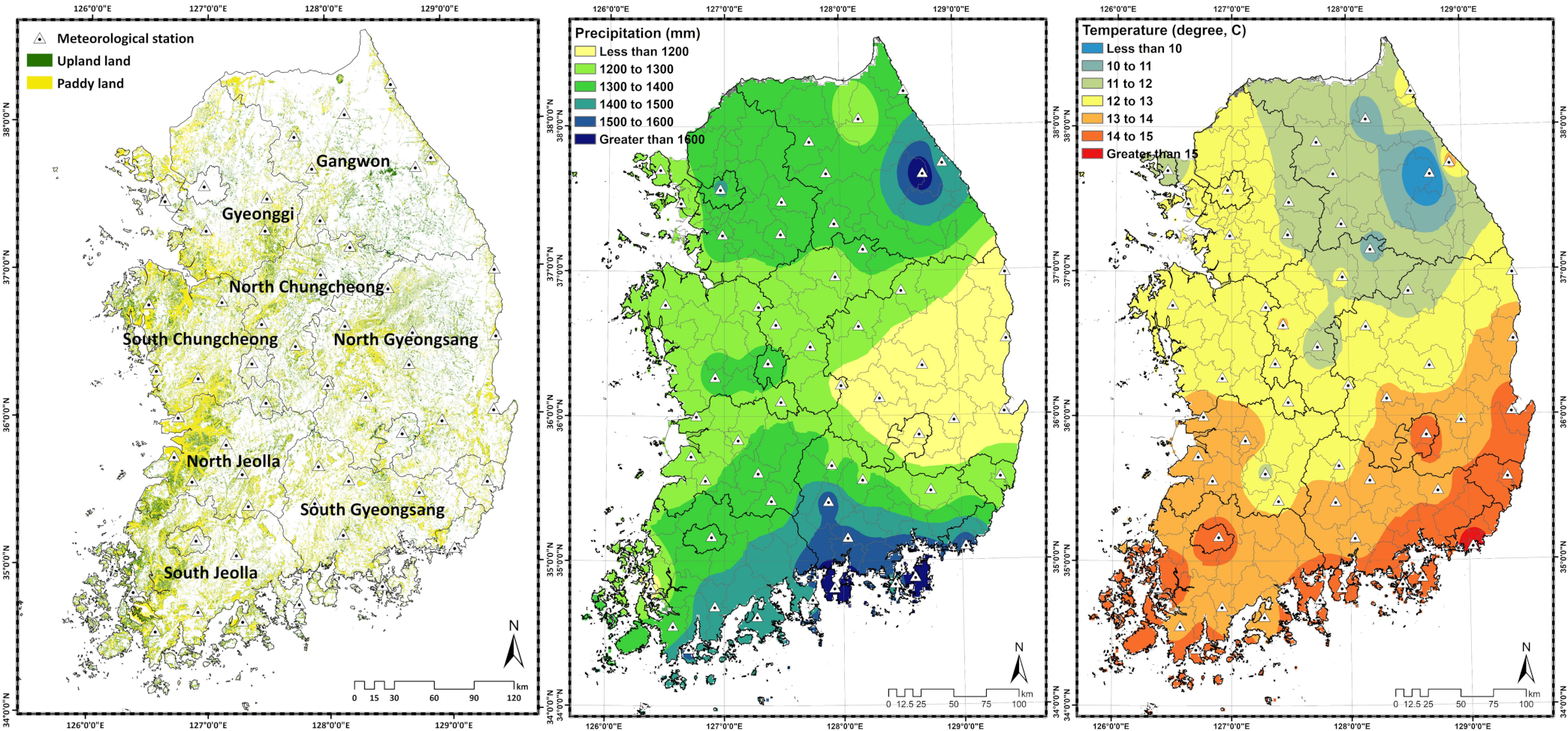
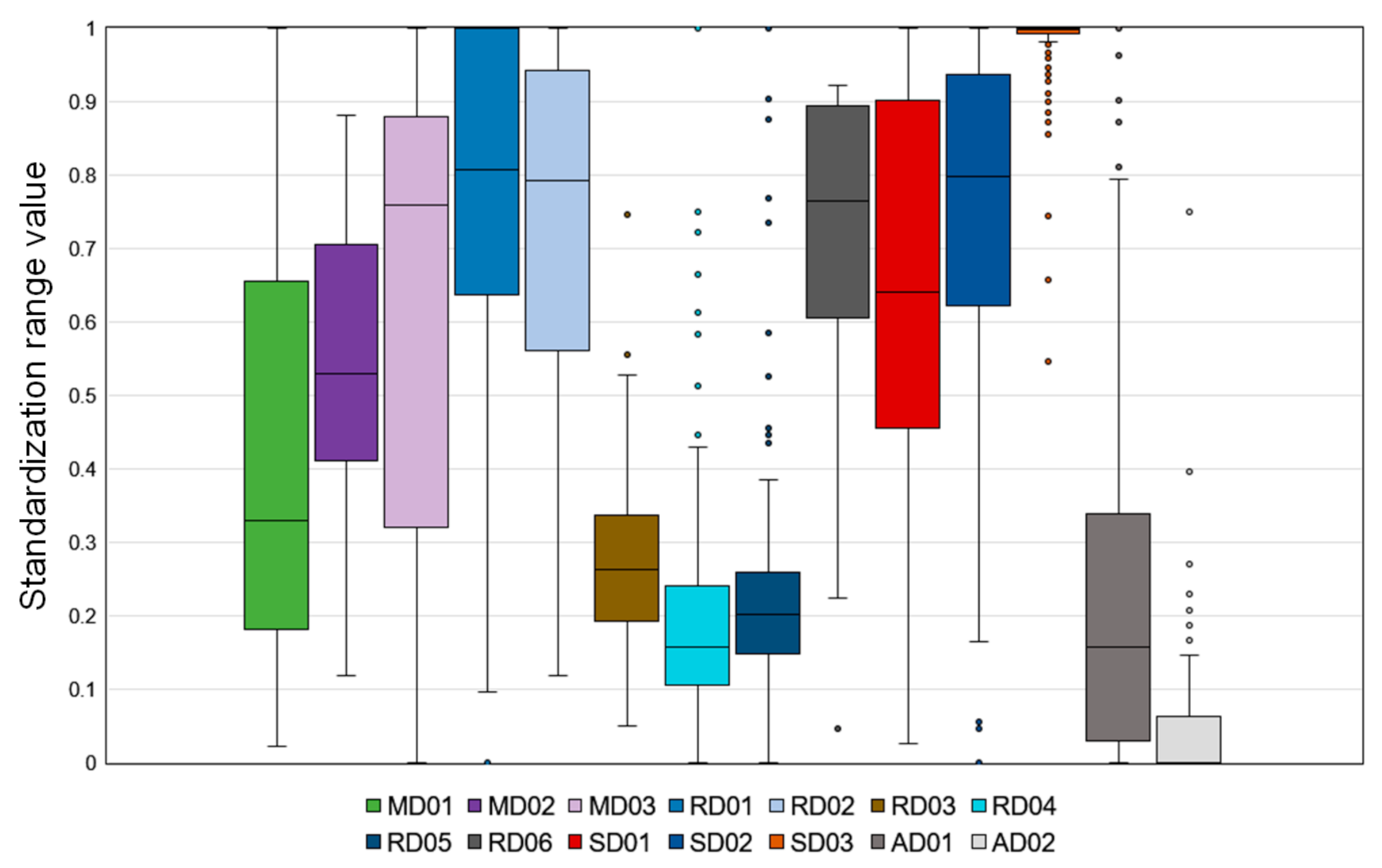
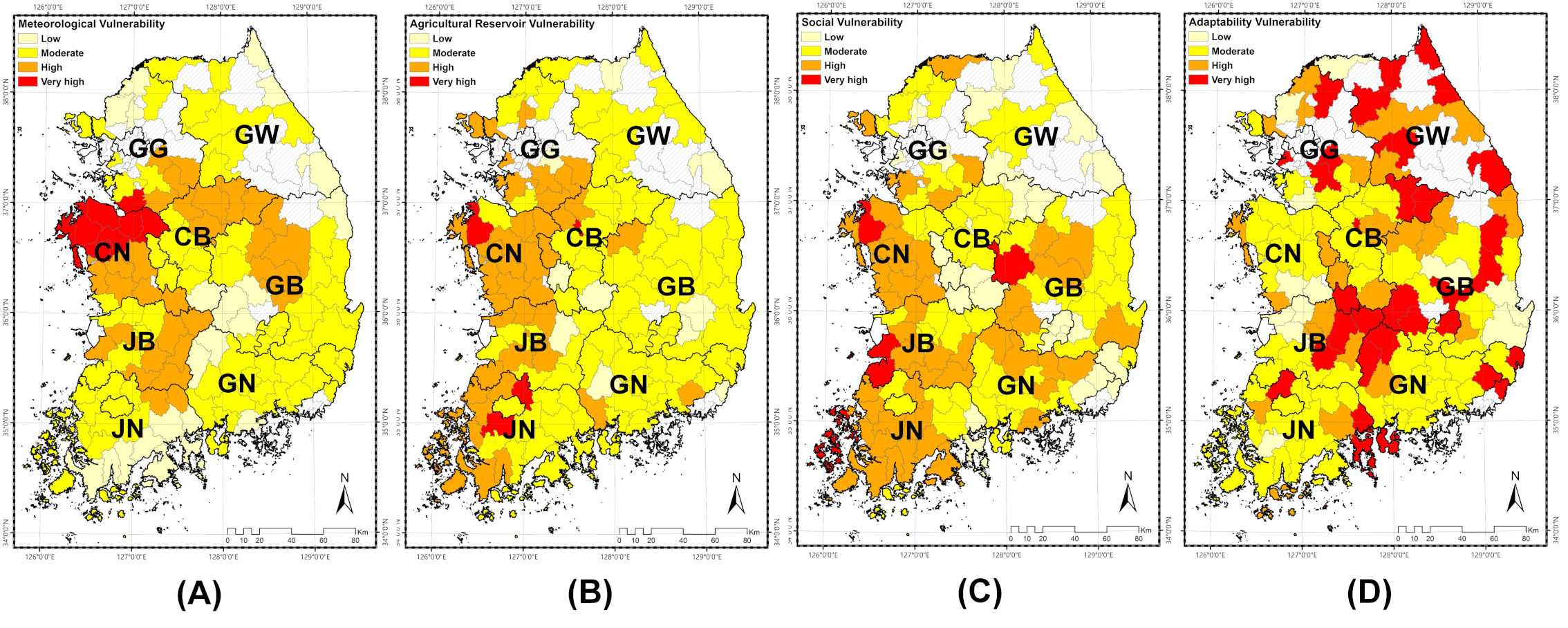
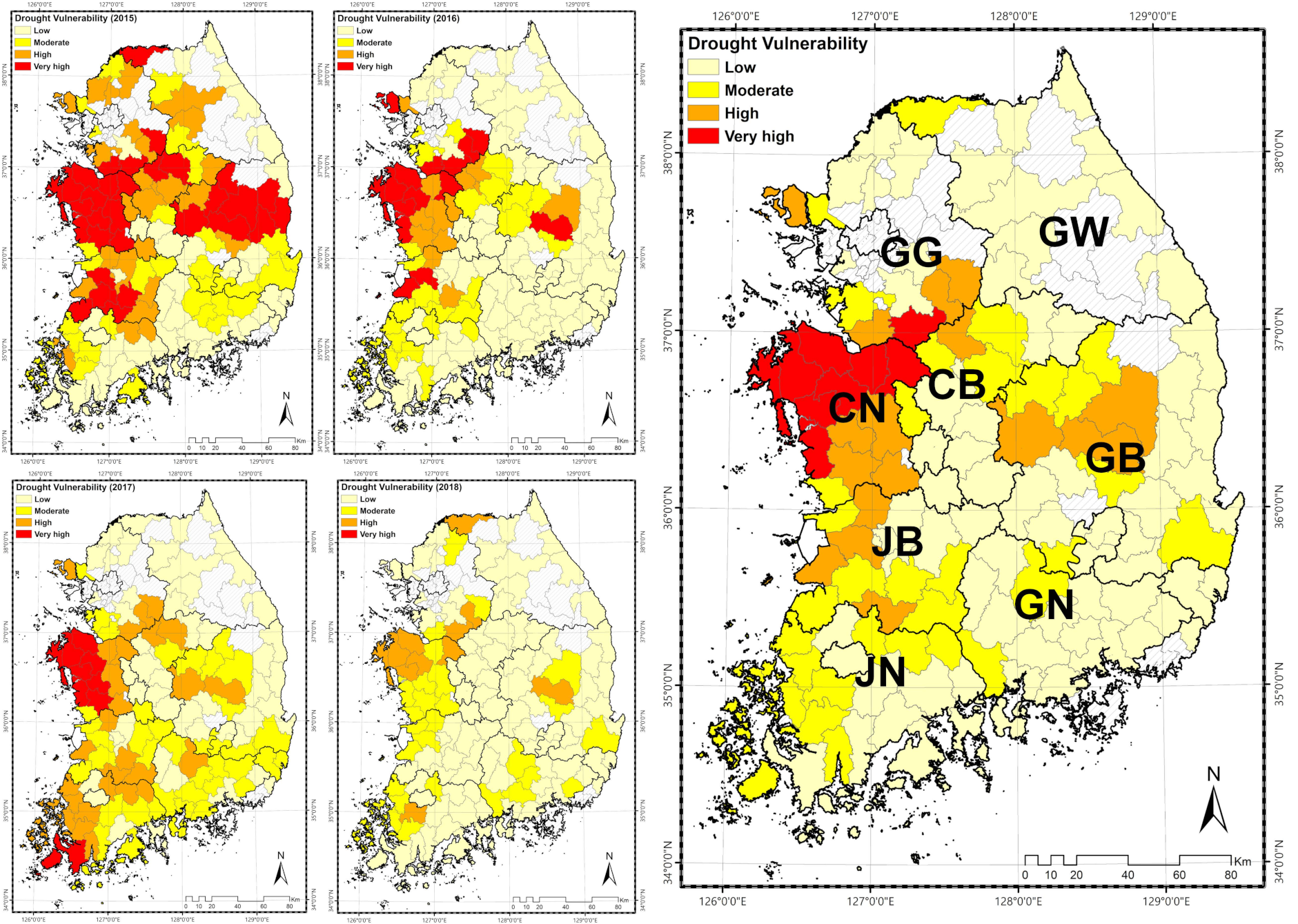
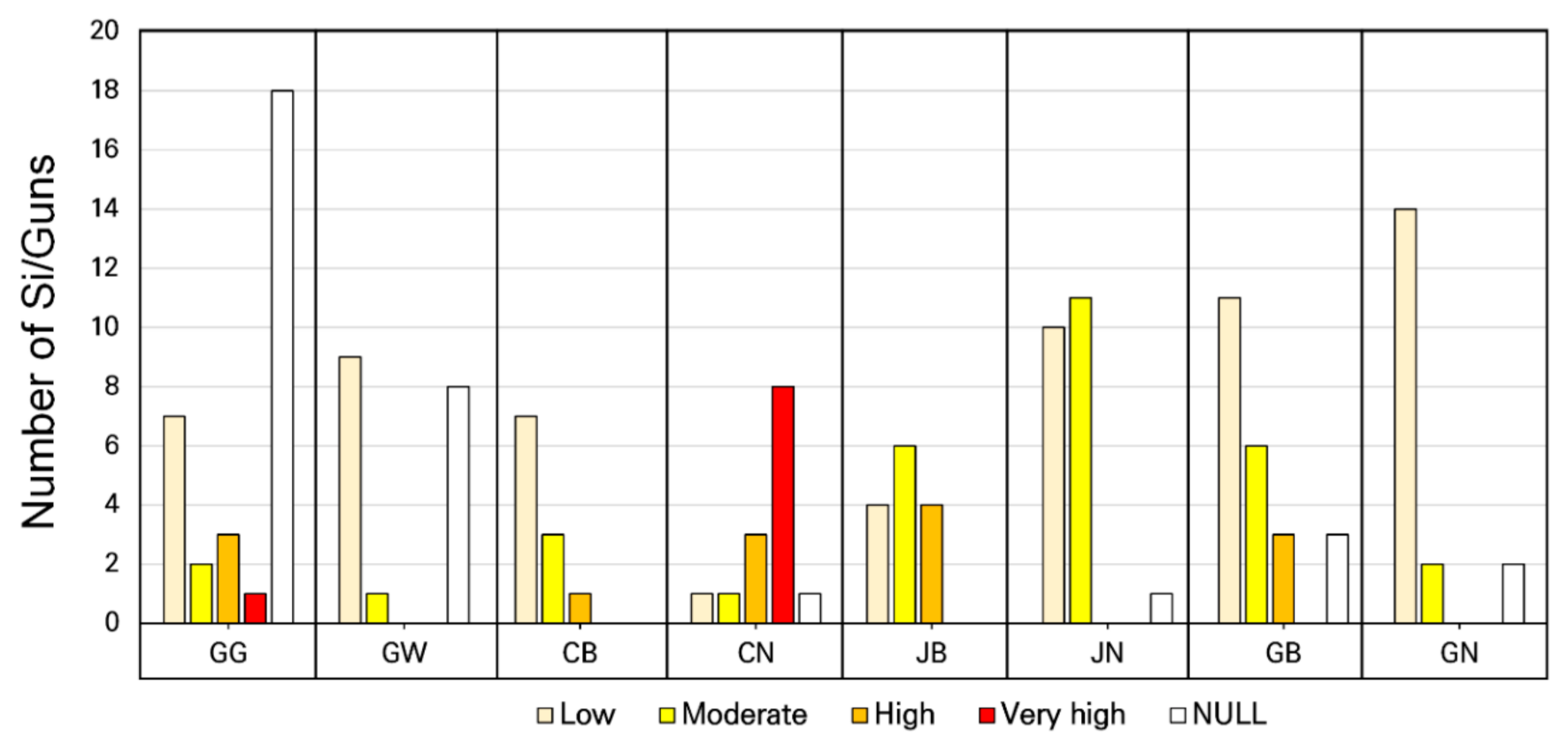
| Category | Abbreviation | Details |
|---|---|---|
| Meteorological data | MD01 | Monthly precipitation |
| MD02 | Number of days without precipitation | |
| MD03 | Number of days having a high temperature over 33 °C |
| Category | Abbreviation | Details |
|---|---|---|
| Agricultural reservoir data | RD01 | Number of days in which the water reserve rate was below the drought warning level of interest |
| RD02 | End-of-month water reserve ratio | |
| RD03 | Reservoir water level reduction ratio | |
| RD04 | Watershed ratio | |
| RD05 | Effective storage reserve per unit area | |
| RD06 | Irrigated paddy field |
| Category | Abbreviation | Details |
|---|---|---|
| Social data | SD01 | Agricultural population ratio |
| SD02 | Rice paddy ratio | |
| SD03 | Paddy water dry area |
| Category | Abbreviation | Details |
|---|---|---|
| Adaptability data | AD01 | Assistance waterworks |
| AD02 | Pumped storage |
| Category | Weight | Classification | Abbreviation | Weight |
|---|---|---|---|---|
| Meteorological data | 0.498 | Monthly precipitation | MD01 | 0.54 |
| Number of days without precipitation | MD02 | 0.35 | ||
| Number of days having a high temperature over 33 °C | MD03 | 0.11 | ||
| Agricultural reservoir data | 0.286 | Number of days in which the water reserve rate was below the drought warning level of interest | RD01 | 0.32 |
| End-of-month water reserve ratio | RD02 | 0.25 | ||
| Reservoir water level reduction ratio | RD03 | 0.15 | ||
| Watershed ratio | RD04 | 0.13 | ||
| Effective storage reserve per unit area | RD05 | 0.09 | ||
| Irrigated paddy field | RD06 | 0.06 | ||
| Social data | 0.166 | Agricultural population ratio | SD01 | 0.22 |
| Rice paddy ratio | SD02 | 0.42 | ||
| Paddy water dry area | SD03 | 0.36 | ||
| Adaptability data | 0.05 | Assistance waterworks | AD01 | 0.79 |
| Pumped storage | AD02 | 0.21 |
| Meteorological | Agricultural Reservoir | Social | Adaptability | |||||
|---|---|---|---|---|---|---|---|---|
| Average | Standard | Average | Standard | Average | Standard | Average | Standard | |
| GG | 69.80 (+) | 69.19 | 72.93 (−) | 75.26 | 89.31 (+) | 80.57 | 49.33 (−) | 59.27 |
| GW | 71.56 (+) | 82.12 (+) | 88.86 (+) | 46.43 (−) | ||||
| CB | 65.25 (−) | 77.07 (+) | 86.83 (+) | 60.95 (+) | ||||
| CN | 57.96 (−) | 69.27 (−) | 71.50 (−) | 69.19 (+) | ||||
| JB | 65.60 (−) | 74.38 (−) | 72.35 (−) | 66.91 (+) | ||||
| JN | 73.09 (+) | 71.76 (−) | 72.41 (−) | 66.70 (+) | ||||
| GB | 68.07 (−) | 78.40 (+) | 77.40 (−) | 64.71 (+) | ||||
| GN | 73.87 (+) | 77.63 (+) | 81.80 (+) | 63.45 (+) | ||||
| Rate (%) | Low (D) | Moderate (C) | High (B) | Very High (A) | Blank |
|---|---|---|---|---|---|
| 2015 | 24.55 | 17.94 | 15.57 | 18.56 | 2.34 |
| 2016 | 44.91 | 14.97 | 7.78 | 8.98 | 2.34 |
| 2017 | 29.34 | 24.55 | 16.77 | 5.99 | 2.34 |
| 2018 | 53.29 | 16.77 | 6.59 | 0.00 | 2.34 |
| Total | 41.91 | 19.76 | 9.58 | 5.39 | 2.34 |
Publisher’s Note: MDPI stays neutral with regard to jurisdictional claims in published maps and institutional affiliations. |
© 2020 by the authors. Licensee MDPI, Basel, Switzerland. This article is an open access article distributed under the terms and conditions of the Creative Commons Attribution (CC BY) license (http://creativecommons.org/licenses/by/4.0/).
Share and Cite
Mun, Y.-S.; Nam, W.-H.; Jeon, M.-G.; Bang, N.-K.; Kim, T. Assessment of Vulnerability to Drought Disaster in Agricultural Reservoirs in South Korea. Atmosphere 2020, 11, 1244. https://doi.org/10.3390/atmos11111244
Mun Y-S, Nam W-H, Jeon M-G, Bang N-K, Kim T. Assessment of Vulnerability to Drought Disaster in Agricultural Reservoirs in South Korea. Atmosphere. 2020; 11(11):1244. https://doi.org/10.3390/atmos11111244
Chicago/Turabian StyleMun, Young-Sik, Won-Ho Nam, Min-Gi Jeon, Na-Kyoung Bang, and Taegon Kim. 2020. "Assessment of Vulnerability to Drought Disaster in Agricultural Reservoirs in South Korea" Atmosphere 11, no. 11: 1244. https://doi.org/10.3390/atmos11111244





